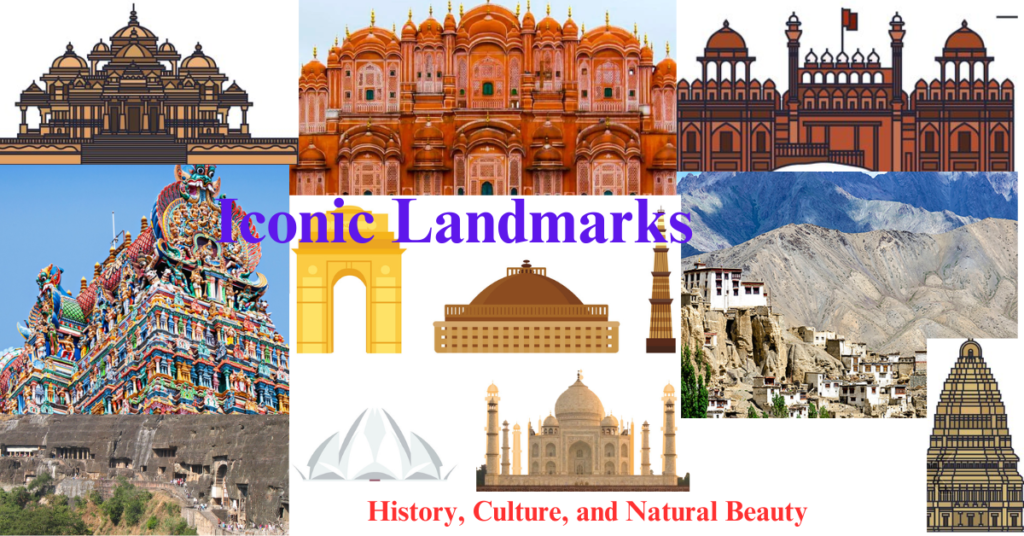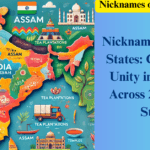
Exploring India’s 15 Iconic Landmarks: A Journey Through History, Culture, and Natural Beauty
Table of Contents
Discovering India’s Famous Landmarks . Renowned Locales of India allude to the assorted and socially rich objections across the Indian subcontinent that hold huge authentic, compositional, profound, and regular significance. These locales incorporate old sanctuaries, grand posts, quiet backwaters, clamoring urban communities, peaceful cloisters, and novel scenes, each offering a brief look into India’s brilliant past and dynamic present. Striking models incorporate the notorious Taj Mahal, the illustrious castles of Jaipur, the profound city of Varanasi, the pleasant backwaters of Kerala, and the noteworthy caverns of Ajanta and Ellora. These locations draw in great many guests from around the world, giving a vivid encounter of India’s legacy, culture, and regular beauty.India, is a place that is known for rich and renowned legacy, social variety, various dialects and verifiable importance, is home to probably the most notable and stunning locales on the planet. Every district of the nation offers an exceptional/different look into its brilliant past, staggering engineering, and regular magnificence. From old sanctuaries and great strongholds to peaceful backwaters and clamoring urban communities, India is a mother lode for voyagers and history fans the same.
India’s 15 Iconic Landmarks given below :
1. Taj Mahal, Agra
Location: Agra, Uttar Pradesh
Significance: A symbol of love and one of the Seven Wonders of the World
Built By: Emperor Shah Jahan
Year: Completed in 1653
The Taj Mahal, a UNESCO World Heritage site, is perhaps the most iconic symbol of India. This white marble mausoleum was built by Emperor Shah Jahan in memory of his beloved wife Mumtaz Mahal. Its stunning architecture, intricate carvings, and beautiful gardens make it a masterpiece of Mughal art. The Taj Mahal’s beauty is especially mesmerizing at sunrise and sunset, when the changing light casts a magical glow on the marble.
2. Jaipur, Rajasthan
Location: Rajasthan
Significance: Known as the Pink City, famous for its royal heritage and architecture
Jaipur, the capital city of Rajasthan, is renowned for its regal charm and vibrant culture. The city is part of the Golden Triangle tourist circuit, along with Delhi and Agra. Notable sites in Jaipur include:
- Amber Fort: A majestic fort with a blend of Hindu and Mughal architecture, offering panoramic views of the surrounding hills.
- Hawa Mahal (Palace of Winds): An iconic pink sandstone structure with a façade featuring 953 small windows, designed to allow royal ladies to observe street festivities without being seen.
- City Palace: A splendid complex of courtyards, gardens, and buildings, reflecting the grandeur of Rajput architecture.
3. Varanasi, Uttar Pradesh
Location: Uttar Pradesh
Significance: One of the oldest living cities in the world, a major religious hub for Hindus
Varanasi, also known as Kashi or Benares, is one of the holiest cities in Hinduism. Situated on the banks of the Ganges River, it is a place where spirituality and tradition are deeply intertwined. Key attractions include:
- Ghats: The riverfront steps where pilgrims perform rituals, including the famous Dashashwamedh Ghat and Manikarnika Ghat.
- Kashi Vishwanath Temple: A revered temple dedicated to Lord Shiva, attracting thousands of devotees daily.
- Sarnath: A nearby site where Lord Buddha delivered his first sermon after attaining enlightenment.
4. Kerala Backwaters
Location: Kerala
Significance: A network of interconnected canals, rivers, and lakes, offering a tranquil experience
The Kerala backwaters are a unique ecosystem and one of the most scenic attractions in India. A cruise on a traditional houseboat (kettuvallam) through the serene waters, lined with lush greenery, offers a glimpse into the rural life of Kerala. Key locations within the backwaters include:
- Alleppey (Alappuzha): Known as the Venice of the East, famous for its houseboat cruises.
- Kumarakom: A cluster of small islands with a bird sanctuary, ideal for nature lovers.
- Kollam: A starting point for backwater cruises, rich in cultural heritage and history.
5. Khajuraho Group of Monuments
Location: Madhya Pradesh
Significance: Renowned for their erotic sculptures and architectural brilliance
Built By: Chandela dynasty
Year: 950 to 1050 AD
The Khajuraho Group of Monuments is a UNESCO World Heritage site, known for its exquisite temples adorned with intricate carvings and sculptures. These temples celebrate various aspects of life, including spirituality, love, and art. The Western Group of Temples, including the Kandariya Mahadeva Temple, is particularly famous for its stunning architectural detail.
6. Goa
Location: Western coast of India
Significance: Famous for its beaches, Portuguese heritage, and vibrant nightlife
Goa is synonymous with pristine beaches, laid-back vibes, and a blend of Indian and Portuguese cultures. Key attractions in Goa include:
- Baga and Anjuna Beaches: Popular spots for water sports, nightlife, and beach parties.
- Basilica of Bom Jesus: A UNESCO World Heritage site housing the relics of St. Francis Xavier.
- Old Goa: An area rich in colonial architecture and historic churches, reflecting the state’s Portuguese past.
7. Delhi
Location: National capital territory
Significance: A city with a rich historical and political significance, blending ancient and modern attractions
Delhi, the capital city of India, is a melting pot of cultures, history, and modernity. Some of the key most important sites in Delhi include:
- Red Fort: A UNESCO World Heritage site and a symbol of India’s rich history, built by Mughal Emperor Shah Jahan.
- Qutub Minar: The tallest brick minaret in the world, surrounded by historical monuments.
- India Gate: A war memorial dedicated to Indian soldiers who died in World War I.
- Lotus Temple: A Bahá’í House of Worship known for its distinctive lotus-shaped architecture.
8. Mysore, Karnataka
Location: Karnataka
Significance: Known as the City of Palaces, famous for its Dasara festival
Mysore, with its royal heritage and cultural vibrancy, is one of the most popular tourist destinations in South India. Notable attractions include:
- Mysore Palace: A grand palace with an Indo-Saracenic style of architecture, illuminated during the Dasara festival.
- Chamundi Hill: A hilltop temple dedicated to Goddess Chamundeshwari, offering panoramic views of the city.
- Brindavan Gardens: Famous for its musical fountain and beautifully landscaped gardens.
9. Hampi, Karnataka
Location: Karnataka
Significance: A UNESCO World Heritage site, known for its ruins of the Vijayanagara Empire
Hampi, the erstwhile capital of the Vijayanagara Empire, is a treasure trove of ancient temples, palaces, and market streets. The site is renowned for its Dravidian architecture and historical significance. Key attractions include:
- Virupaksha Temple: A functioning temple and one of the oldest structures in Hampi.
- Vittala Temple: Famous for its musical pillars and the iconic stone chariot.
- Hampi Bazaar: An ancient market street that once thrived with traders and artisans.
10. Leh-Ladakh, Jammu and Kashmir
Location: Jammu and Kashmir
Significance: Known for its stunning landscapes, monasteries, and adventure tourism
Leh-Ladakh, often referred to as the “Land of High Passes,” is a region of breathtaking beauty and serene monasteries. Popular attractions include:
- Pangong Lake: A high-altitude lake known for its changing colors and stunning scenery.
- Thiksey Monastery: A beautiful monastery offering panoramic views of the Indus Valley.
- Nubra Valley: Known for its sand dunes, Bactrian camels, and scenic vistas.
11. Rishikesh and Haridwar, Uttarakhand
Location: Uttarakhand
Significance: Major pilgrimage sites and hubs for yoga and adventure sports
Rishikesh and Haridwar, located along the banks of the Ganges River, are prominent spiritual and adventure destinations. Key attractions include:
- Ganga Aarti: A daily evening ritual at Har Ki Pauri in Haridwar, attracting thousands of devotees.
- Laxman Jhula: A suspension bridge in Rishikesh, offering stunning views of the Ganges.
- Yoga Ashrams: Rishikesh is known as the Yoga Capital of the World, with numerous ashrams and wellness centers.
12. Udaipur, Rajasthan
Location: Rajasthan
Significance: Known as the City of Lakes, famous for its palaces and scenic beauty
Udaipur, with its picturesque lakes and royal palaces, is a city of romance and elegance. Key attractions include:
- City Palace: A grand palace complex with museums, courtyards, and stunning views of Lake Pichola.
- Lake Pichola: A serene lake with boat rides offering views of the surrounding palaces and ghats.
- Jag Mandir: An island palace on Lake Pichola, known for its beautiful architecture and gardens.
13. Amritsar, Punjab
Location: Punjab
Significance: Home to the Golden Temple, a major pilgrimage site for Sikhs
Amritsar is a city of spiritual and historical significance. The Golden Temple, also known as Harmandir Sahib, is the holiest shrine in Sikhism. Key attractions include:
- Golden Temple: A stunning gold-plated temple surrounded by a sacred pool, offering a serene and spiritual experience.
- Jallianwala Bagh: A memorial garden commemorating the victims of the 1919 massacre.
- Wagah Border: A ceremonial border crossing between India and Pakistan, known for its daily flag-lowering ceremony.
14. Rann of Kutch, Gujarat
Location: Gujarat
Significance: A unique salt marsh and one of the largest salt deserts in the world
The Rann of Kutch, with its vast expanse of white salt, is a surreal and mesmerizing landscape. The Rann Utsav, a cultural festival held annually, showcases the vibrant culture of Gujarat. Key attractions include:
- Great Rann of Kutch: A stunning white desert, especially beautiful during the full moon.
- Kutch Wildlife Sanctuary: Home to a variety of wildlife, including the Indian wild ass and migratory birds.
- Bhuj: A historic city with palaces, temples, and handicrafts.
15. Ajanta and Ellora Caves, Maharashtra
Location: Maharashtra
Significance: UNESCO World Heritage sites known for their rock-cut architecture and exquisite sculptures
The Ajanta and Ellora Caves are remarkable examples of ancient rock-cut architecture. These caves are adorned with intricate carvings and paintings, showcasing the artistic brilliance of ancient India. Key highlights include:
- Ajanta Caves: A series of Buddhist caves with stunning frescoes and sculptures, dating back to the 2nd century BCE.
- Ellora Caves: A complex of Hindu, Buddhist, and Jain caves, with the Kailasa Temple being the most famous for its monolithic rock-cut architecture.
Conclusion
India’s famous sites offer a fascinating journey through time, History , culture, and natural beauty. From the iconic Taj Mahal to the tranquil backwaters of Kerala, each destination has its unique charm and significance. Whether you are a history buff, a nature lover, or a spiritual seeker, India’s diverse and rich heritage promises an unforgettable experience. Exploring these Iconic Landmarks and History, Culture, and Natural Beautynot only provides a deeper understanding of India’s past but also a greater appreciation of its vibrant present.


